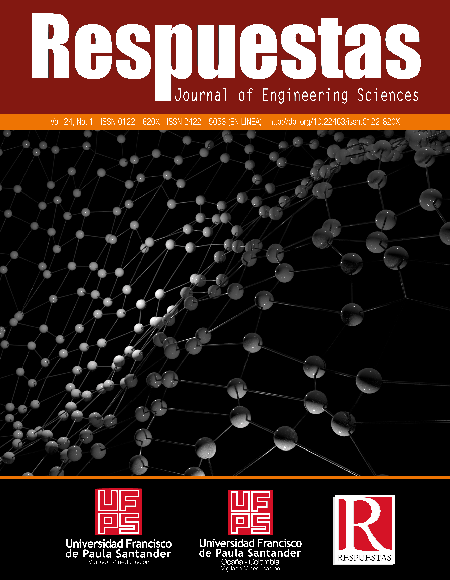Evaluación del daño en la vértebra lumbar L5 mediante análisis por elementos finitos
Evaluation of damage to the lumbar spine vertebrae L5 by finite element analysis
Contenido principal del artículo
La metástasis ósea a la columna vertebral, pelvis o cadera en pacientes con cáncer de próstata es una patología que se presenta en aproximadamente el 80% de los casos. Las metástasis en la columna vertebral pueden causar dolor, inestabilidad y lesiones neurológicas. Por lo tanto, es importante evaluar cuándo se han alcanzado las condiciones críticas y se ha comprometido la integridad estructural del hueso. Los métodos numéricos basados en los datos de los pacientes, obtenidos mediante el post-procesamiento de imágenes médicas, proporcionan una herramienta para modelar la complejidad del material tisular biológico. La tomografía axial computarizada (TC) junto con herramientas de segmentación permite la reconstrucción de modelos óseos en 3D que incluyen propiedades mecánicas, y que representan el estado anisotrópico de las estructuras óseas. En este trabajo se presenta el modelo de vértebras lumbares L5 de un paciente afectado por metástasis y se evalúan los biomarcadores para indicar el nivel de daño, en comparación con el caso de referencia de hueso sano en una fase inicial.
Descargas
Detalles del artículo
J. P. Karr, “Prostate Cancer in the United States and Japan,” in Prostate Cancer and Bone Metastasis. Advances in Experimental Medicine and Biology, vol 324, J. P. Karr and H. Yamanaka, Eds. Boston, MA: Springer, 1992, pp. 17–28.
F. E. Lecouvet et al., “Magnetic resonance imaging of the axial skeleton for detecting bone metastases in patients with high-risk prostate cancer: Diagnostic and cost-effectiveness and comparison with current detection strategies,” J. Clin. Oncol.,vol. 25, no. 22, pp. 3281–3287, 2007, doi:10.1200/JCO.2006.09.2940.
G. R. Mundy, “Metastasis to bone: Causes, consequences and therapeutic opportunities,” Nat. Rev. Cancer, vol. 2, no. 8, pp. 584–593, 2002, doi:10.1038/nrc867.
Instituto Nacional de Cancerología - Colombia, “Cáncer en cifras,” http://www.cancer.gov.co/cancer_en_cifras, 2018/02/16, 2018.
M. Eleraky, I. Papanastassiou, and F. D. Vrionis, “Management of metastatic spine disease,” Curr. Opin. Support. Palliat. Care, vol. 4, no. 3, pp. 182–188, Sep. 2010, doi:10.1097/SPC.0b013e32833d2fdd.
D. Vanel, J. Bittoun, and A. Tardivon, “MRI of bone metastases,” Eur. Radiol., vol. 8, no. 8, pp. 1345–1351, Sep. 1998, doi:10.1007/s003300050549.
H. K. Genant, K. Engelke, and S. Prevrhal, “Advanced CT bone imaging in osteoporosis,” Rheumatology, vol. 47, no. SUPPL. 4, 2008, doi:10.1093/rheumatology/ken180.
R. Castilla, L. Forero, and O. A. González- Estrada, “Comparative study of the influence of dental implant design on the stress and strain distribution using the finite element method,” J. Phys. Conf. Ser., vol. 1159, p. 012016, Jan. 2018, doi:10.1088/1742-6596/1159/1/012016.
M. Vera et al., “Segmentation of brain tumors using a semi-automatic computational strategy,” J. Phys. Conf. Ser., vol. 1160, p. 012002, 2019, doi:10.1088/1742-6596/1160/1/012002.
E. Nadal Soriano, M. J. Rupérez, S. Martínez Sanchis, C. Monserrat Aranda, M. Tur, and F. J. Fuenmayor, “Evaluación basada en el método del gradiente de las propiedades elásticas de tejidos humanos in vivo,” Rev. UIS Ing., vol. 16, no. 1, pp. 15–22, Oct. 2017, doi:10.18273/revuin.v16n1-2017002.
O. A. González-Estrada, S. Natarajan, J. J. Ródenas, H. Nguyen-Xuan, and S. P. A. Bordas, “Efficient recovery-based error estimation for the smoothed finite element method for smooth and singular linear elasticity,” Comput. Mech., vol. 52, no. 1, pp. 37–52, Sep. 2013, doi:10.1007/s00466-012-0795-6.
M. W. Layton, S. A. Goldstein, R. W. Goulet,L. A. Feldkamp, D. J. Kubinski, and G. G. Bole,“Examination of subchondral bone architecture in experimental osteoarthritis by microscopic computed axial tomography,” Arthritis Rheum., vol. 31, no. 11, pp. 1400–1405, Nov. 1988, doi:10.1002/art.1780311109.
E. Avrahami, R. Tadmor, O. Dally, and H. Hadar,“Early MR Demonstration of Spinal Metastases in Patients with Normal Radiographs and CT and Radionuclide Bone Scans,” J. Comput. Assist. Tomogr., vol. 13, no. 4, pp. 598–602, Jul. 1989,doi:10.1097/00004728-198907000-00008.
S. Schievano et al., “Percutaneous Pulmonary Valve Implantation Based on Rapid Prototyping of Right Ventricular Outflow Tract and Pulmonary Trunk from MR Data,” Radiology, vol. 242, no. 2,pp. 490–497, 2007, doi:10.1148/radiol.2422051994.
F. Valencia-Aguirre, C. Mejía-Echeverria, and V. Erazo-Arteaga, “Desarrollo de una prótesis de rodilla para amputaciones transfemorales usando herramientas computacionales,” Rev. UIS Ing.,vol. 16, no. 2, pp. 23–34, 2017, doi:https://doi.org/10.18273/revuin.v16n2-2017002.
W. C. C. Lee, M. Zhang, X. Jia, and J. T. M. Cheung, “Finite element modeling of the contact interface between trans-tibial residual limb and prosthetic socket,” Med. Eng. Phys., vol. 26, no. 8, pp. 655–662, 2004, doi:10.1016/j.medengphy.2004.04.010.
S. A. Ardila Parra, O. A. González-Estrada,and J. E. Quiroga Mendez, “Damage Assessment of Spinal Bones due to Prostate Cancer,” Key Eng. Mater., vol. 774, pp. 149–154, 2018, doi:10.4028/www.scientific.net/KEM.774.149.
A. M. Pham, A. A. Rafii, M. C. Metzger, A. Jamali, and E. B. Strong, “Computer modeling and intraoperative navigation in maxillofacial surgery,”Otolaryngol. - Head Neck Surg., vol. 137, no. 4, pp.624–631, 2007, doi:10.1016/j.otohns.2007.06.719.
J. Y. Rho, M. C. Hobatho, and R. B. Ashman, “Relations of mechanical properties to density and CT numbers in human bone,” Med. Eng. Phys., vol. 17, no. 5, pp. 347–355, Jul. 1995, doi:10.1016/1350-4533(95)97314-F.
J. H. Keyak, J. M. Meagher, H. B. Skinner, and C. D. Mote, “Automated three-dimensional finite element modelling of bone: a new method,”J. Biomed. Eng., vol. 12, no. 5, pp. 389–397, Sep. 1990, doi:10.1016/0141-5425(90)90022-F.
E. Schileo, F. Taddei, A. Malandrino, L. Cristofolini, and M. Viceconti, “Subject-specific finite element models can accurately predict strain levels in long bones,” J. Biomech., vol. 40, no. 13, pp. 2982–2989, 2007, doi:10.1016/j.jbiomech.2007.02.010.
A. Nachemson, “The Load on Lumbar Disks in Different Positions of the Body,” Clin. Orthop. Relat. Res., vol. 45, no. 1, pp. 107–122, 1966,doi:10.1097/00003086-196600450-00014.
J. D. Tobin, K. M. Fox, M. L. Cejku, T. A. Roy, R. S. Epstein, and C. C. Plato, “Bone density changes in normal men: a 4–19 year longitudinal study,” J.Bone Miner. Res., vol. 8, no. suppl 1, p. S142, 1993.
T. Suzuki, T. Shimizu, K. Kurokawa, H. Jimbo, J. Sato, and H. Yamanaka, “Pattern of prostate cancer metastasis to the vertebral column.,” Prostate, vol. 25, no. 3, pp. 141–146, 1994.







